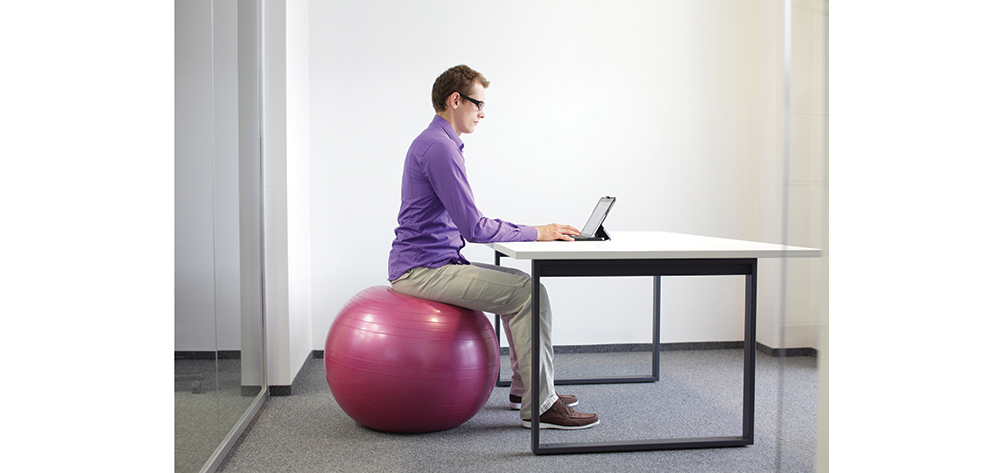Telehealth, telemedicine, and home-based telehealth work have grown dramatically in recent years. These programs enable nurses to provide patient care remotely from a medical office or their own home. Research shows telehealth programs have many benefits for patients and healthcare organizations.
But whether telehealth nurses work from home or an office, they’re at risk for negative health effects of a sedentary job. For decades, we’ve known a sedentary lifestyle doesn’t promote good health. Research shows prolonged sitting can cause various health problems. According to Marc T. Hamilton, PhD, an inactivity physiology researcher, sitting is the new smoking. Prolonged sitting increases risk for type 2 diabetes, obesity, and cardiac abnormalities and may reduce work productivity.
Fortunately, many of the health problems linked to a sedentary lifestyle are preventable, largely through strategies that center on balancing work and life. As most nurses know, promoting a work-life balance for yourself can be harder than advocating it for others. We’re great at coaching patients to modify their lifestyles, but sometimes find it hard to practice what we preach.
Working from home, as many telehealth nurses do, can bring its own challenges. Being isolated from coworkers and working longer hours than they would in an office environment can cause mental and physical stress and exhaustion. Work-at-home nurses also may have trouble compartmentalizing work and home responsibilities, which sets the stage for work-home conflict. A 2014 Swedish study found conflict between home and work can lead to burnout and depression. The perceived need to stay glued to the computer and phone can make it especially hard to get away from work demands.
To be more physically active, telehealth workers need to change their behavior and habits. For office nurses, employer-based strategies are needed. For home-based nurses, self-discipline is crucial.
Promoting health for office telehealth nurses
A national prevention initiative by the U.S. Department of Health and Human Services focuses on promoting a healthier work environment by improving workers’ health. Created by the Affordable Care Act, this initiative focuses on establishing workplace programs and policies to improve the quality of life for workers. It encourages employers to become partners in health promotion by developing appropriate workplace policies and offering employees programs that help them make better health choices, reduce illness, and promote safety.
Creating a less sedentary work environment means getting employees to become more physically active and promoting ergonomic office-furniture design. The result is a win-win situation for all involved. More physically active employees can lead to a more productive work environment, in turn decreasing sick days and promoting healthy habits. (See Tools to improve the work environment.)
To help telehealth office workers become more physically active, employers can create walking paths and promote walking groups during lunch hours, provide better access to fitness facilities, and allow workers to use physical therapy equipment during lunch hours. Also, some employers offer physical challenge programs, such as walking or weight reduction, in which participants log their weight or miles walked. At the end of the challenge period, the winner receives a prize. Employers also may offer healthy practice tips to employees or stage demonstrations of healthy alternative cooking with free food samples and recipes. In addition, health insurance companies are offering incentives for reaching goals, as well as rewards for customers who complete an online health risk assessment and follow through with tips to promote change. The rewards may be money applied to copays, subsidized gym memberships, or free products, such as pedometers.
Here are more tips to keep you moving in your office-based telehealth job:
- Stand at your desk at least 5 minutes every hour to stretch and move your arms and legs. Brief periods of standing help renew concentration, improve motivation, and get those creative juices flowing.
- Take walks during 15-minute breaks.
- Stand when making your next phone call.
- Stage short meetings standing up.
- Walk to the water cooler for your next cup of water.
- Walk your patient out of your office.
- Try to arrange to work at home several days of the week.
- Instead of sending e-mails to coworkers, get up and go to their work locations to communicate face to face.
Promoting health for home telehealth nurses
Striving for a healthy work-life balance is especially vital for home telehealth workers. Stand for at least 5 minutes every hour to stretch and move around. Set an alarm on your clock, watch, or smartphone to go off every hour—a reminder that it’s time to get up and exercise. If you have a dog, take a break to walk it and get some fresh air. If you do yoga, try to squeeze in a session during your work hours.
During your lunch break, step away from your desk or take a walk. A change in scenery at mealtimes refreshes your mind. When possible, arrange to have lunch with a friend so you can focus on socializing instead of work. Also, make an effort to eat healthy foods and take better care of yourself.
Separate your home environment from your work. Create a designated area or room to be used solely for work—one that’s away from home distractions. At the end of your workday, stop taking work-related calls; have messages roll over to your answering system.
Also try these strategies:
- Instead of using the phone or going online for all work-related meetings, make a point to attend every other meeting in person.
- Don’t work past your regular work hours too often.
- When your workday ends, close the door to your designated workspace and start your personal life.
Self-accountability
As a telehealth nurse, you play a valuable part in patient care—but you need to ensure your own health isn’t in peril from a sedentary lifestyle. Remember—movement is crucial to good health. For your physical, mental, and spiritual well-being, put your own health first and foremost no matter where you work. Taking care of others has always been the nurse’s mission, but telehealth nurses need to take care of themselves while promoting healthy lifestyle changes and practices for patients.
(Editor’s note: For more information on being healthy, read about ANA’s HealthyNurseTM program at www.nursingworld.org/MainMenuCategories/WorkplaceSafety/Healthy-Nurse.)
Selected references
Centers for Disease Control and Prevention. Adult obesity facts. Page last reviewed and updated September 9, 2014. www.cdc.gov/obesity/data/adult.html. Accessed September 23, 2014.
Blom V, Sverke M, Bodin L, et al. Work-home interference and burnout: a study based on Swedish twins. J Occup Environ Med. 2014;56(4):361-6.
Department of Health & Human Services. The Surgeon General’s Initiatives. www.surgeongeneral.gov/initiatives. Accessed September 23, 2014.
Neuhaus M, Healy GN, Dunstan DW, Owen N, Eakin EG. Workplace sitting and height-adjustable workstations: a randomized control trial. Am J Prev Med. 2014;46(1):30-40.
Joni Moore-Resilard is a home telehealth care coordinator for the Department of Veterans Affairs, North Florida/South Georgia Veterans Health System, Lake City VA Medical Center, in Lake City, Florida.



















1 Comment.
thanks for the information